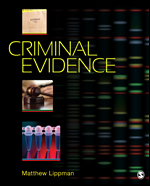Criminal Evidence
Matthew Lippman - University of Illinois at Chicago, USA
A concise and comprehensive introduction to the law of evidence, Criminal Evidence takes an active learning approach to help readers apply evidence law to real-life cases. Bestselling author Matthew Lippman, a professor of criminal law and criminal procedure for over 25 years, creates an engaging and accessible experience for students from a public policy perspective through a multitude of contemporary examples and factual case scenarios that illustrate the application of the law of evidence. Highlighting the theme of a balancing of interests in the law of evidence, readers are asked to apply a more critical examination of the use of evidence in the judicial system. The structure of the criminal justice system and coverage of the criminal investigative process is also introduced to readers.
Available formats
See what’s new to this edition by selecting the Features tab on this page. Should you need additional information or have questions regarding the HEOA information provided for this title, including what is new to this edition, please email sageheoa@sagepub.com. Please include your name, contact information, and the name of the title for which you would like more information. For information on the HEOA, please go to http://ed.gov/policy/highered/leg/hea08/index.html.
For assistance with your order: Please email us at textsales@sagepub.com or connect with your SAGE representative.
SAGE
2455 Teller Road
Thousand Oaks, CA 91320
www.sagepub.com
SAGE edge for Students provides a personalized approach to help students accomplish their coursework goals in an easy-to-use learning environment.
- Mobile-friendly practice quizzes allow for independent assessment by students of their mastery of course material.
- Mobile-friendly eFlashcards strengthen understanding of key terms and concepts.
- An online action plan includes tips and feedback on progress through the course and materials, which allows students to individualize their learning experience.
- Chapter summaries with learning objectives reinforce the most important material.
- Multimedia content includes video and web resources that appeal to students with different learning styles.
SAGE edge for Instructors supports your teaching by making it easy to integrate quality content and create a rich learning environment for students.
- Test banks provide a diverse range of pre-written options as well as the opportunity to edit any question and/or insert your own personalized questions to effectively assess students’ progress and understanding.
A Respondus electronic test bank is available and can be used on PCs. The test bank contains multiple choice, true/false, short answer, and essay questions for each chapter and provides you with a diverse range of pre-written options as well as the opportunity for editing any question and/or inserting your own personalized questions to effectively assess students’ progress and understanding. Respondus is also compatible with many popular learning management systems so you can easily get your test questions into your online course.
- Editable, chapter-specific PowerPoint® slides offer complete flexibility for creating a multimedia presentation for your course.
- Multimedia content includes video and web resources that appeal to students with different learning styles.
- Lecture notes summarize key concepts by chapter to help you prepare for lectures and class discussions.
KEY FEATURES:
- An integrative theme balances different interests in the application of evidence law, such as relevance versus prejudice and efficiency balanced against reliability
- Chapter-opening vignettes introduce readers to a real-life case related to the subject matter of the chapter coverage
- Test Your Knowledge questions appearing at the beginning of each chapter spark student interest by showing them what they know and don’t know prior to reading the upcoming chapter text
- You Decide scenarios based on actual cases appear in each chapter to create an interactive experience by asking students to apply the law to real cases
- Criminal Evidence in the News features provide readers with contemporary examples that are relevant to the concepts being introduced
- Criminal Evidence and Public Policy sections relate evidence to larger public policy issues
- A Case Analysis concluding each chapter examines a legal case covering a challenging issues relating to the material covered in the chapter
- The Federal Rules of Evidence are discussed throughout the text to contrast and compare different approaches of various state codes
- Chapter Review Questions act as a learning tool to help reinforce important concepts and to confirm understanding of the chapter

